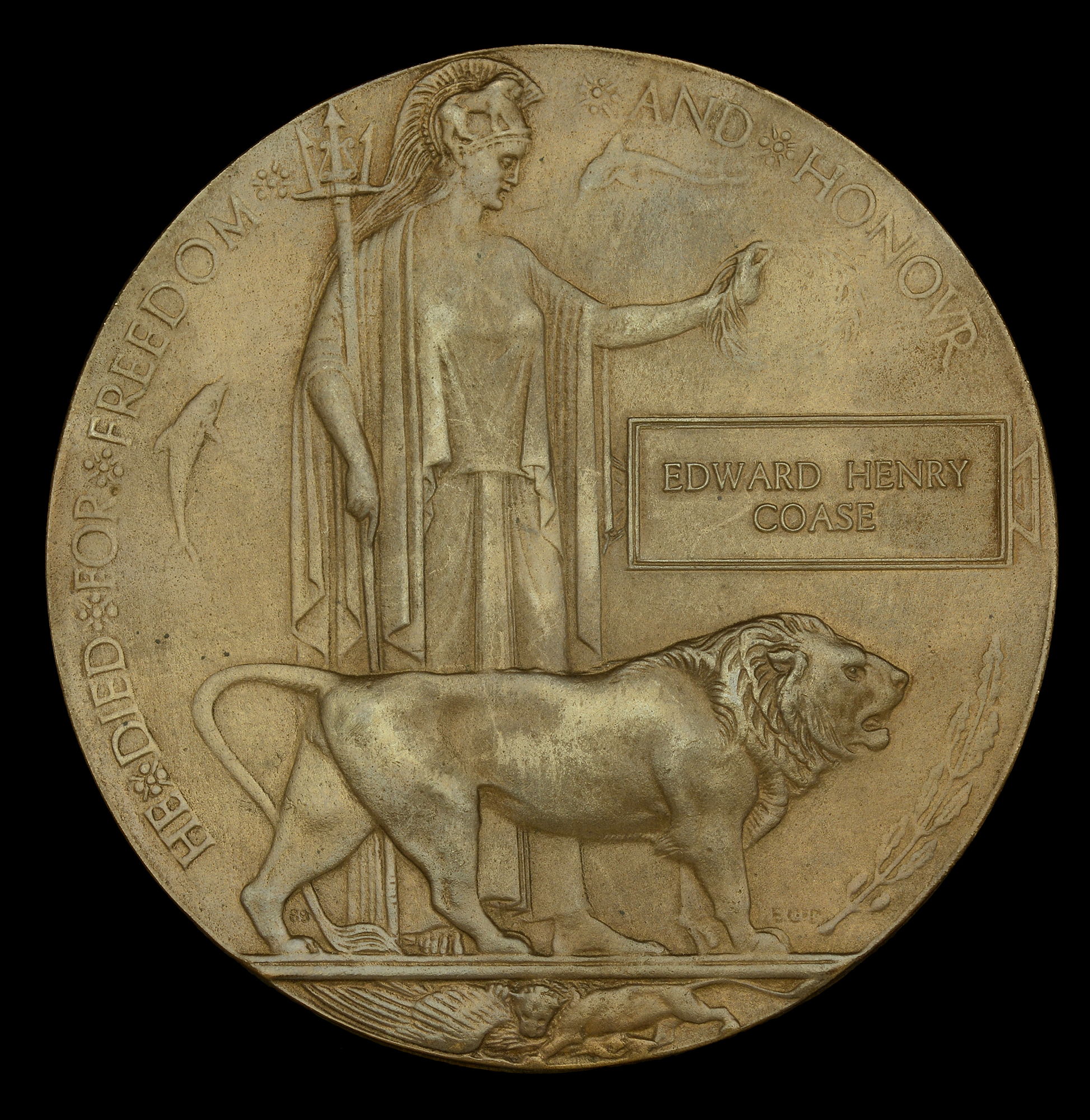The Memorial Plaque to Able Seaman E. H. Coase, Royal Navy, who was killed in the H.M.S. Glowworm explosion on the Dvina River on 25 August 1919 Memorial Plaque 1914-18 (Edward Henry Coase) extremely fine £140-£180 --- Edward Henry Coase was born in Devonport on 5 October 1896 and enlisted into the Royal Navy as a Boy Second Class on 28 March 1912. He entered the War serving on the battleship Centurion, in which he was promoted to Ordinary Seaman in October 1914 and Able Seaman in June 1915. He then served at Vivid I from November 1915 to July 1916, before joining the gunboat Glowworm, based on Halcyon,from July 1916 to September 1918, and subsequently: Pembroke II, from October 1918; Monitor 25, from October 1918 to May 1919; and Fox, June 1919 to August 1919. Able Seaman Coase was killed on 25 August 1919 ‘as a result of the blowing up of an ammunition lighter.’ On the night of 25 August 1919, the gunboats Glowworm and Cockchafer were proceeding down the Dvina River to relieve Cricket and Cicala as part of the advance guard on R.N. gunboats operating on the Dvina. As the Glowworm and Cockchafer neared Bereznik, the watch on the Glowworm spotted a barge on fire mid-river. The Mercantile Marine Reserve and Russian crew of Army barge NT326 Edinburgh had raked out the galley fire as usual before heading to their hammocks for the night. Closer to midnight, two of the crew awoke to find the aft cabin ablaze. Unable to stem the flames, some of the crew fled the barge in a small boat. The crew of the barge had good reason to flee the inferno as they knew what Commander Green onboard Glowworm did not: that the barge was being used to transport ammunition and was loaded with 70 tons of explosive. As Commander Green brought the Glowworm alongside, nose towards the blazing barge, the crew of the gunboat rushed with hoses to fire-stations on the fore-deck in preparation to put out the conflagration. Many of Glowworm’s crew not involved in fighting the fire crowded the fore-deck to watch the brilliant bonfire before them. As the crew of Glowworm began to fight the fire, the Cockchafer, some distance away, began to manoeuvre to approach the barge from another direction. A crowd had gathered ashore of men observing the spectacle. The crowd watched in horror as a huge wall of flame rose into the calm night sky. Soon after there was another explosion and several smaller ones after that. It is unknown how many of Glowworm’s crew died in the initial explosions, but by now it must have been apparent to Commander Green that he had brought his ship alongside a blazing ammunition barge. A few minutes later an enormous flash blanketed the countryside. Seconds later the deafening roar and shock wave of the explosion ripped through air sending debris up to a mile away. Slowly, as those on the shore began to regain their senses, rescue teams hastily cobbled together began to make their way towards Glowworm in whatever vessels they could find. As the rescue teams boarded Glowworm, they could not believe the devastation that awaited them. The entire superstructure seemed to be scorched and bent; debris and the remains of the crew lay everywhere. The fore-deck had suffered the most damage being closest to the explosion. All of the fire-fighting crews had been wiped out whilst manning their hoses. As rescuers came across wounded sailors they carried them to the relatively undamaged after-deck and lay them in rows for the medical staff to attend to. Commander Green was found on the bridge mortally wounded, surrounded by the bodies of other officers and sailors who had been killed outright in the explosion. He was evacuated to the hospital barge which moored alongside the smoking Glowworm, but did not regain consciousness and died an hour later. In the meantime Cockchafer, under Commander Preston Thomas, had come to her stricken sister ship’s aid. She lit the ship with her searchlights to aid the rescue efforts whilst coming alongside. From the bridge of Cockchafer, Commander Thomas directed the rescue crews through a megaphone. The following day, the full scale of the tragedy became apparent. Onboard Glowworm, 23 officers and men had been killed, and another 15 had been wounded. Additionally, two Mercantile Marine Reserve men and two Russian seamen onboard a nearby ammunition barge had been killed by flying debris and three other Mercantile Marine Reserve men wounded. It was the largest loss of life suffered on a single day by the Royal Navy in North Russia in 1918-19. The damage to Glowworm was significant. She was towed back to Archangel to be refitted and repaired and was able to make her way back to England under her own steam, but she was too worn out to continue service and was paid off almost as soon as she arrived back at Chatham on 18 November 1919 and was eventually scrapped in 1921.
Auctioneer's Buyers Premium: 24% (+VAT)
There is an additional charge of 4.95% (+VAT/sales tax)
See Full Terms And Conditions


